Day 1- I get to Tonchigue in the evening. A woman with a little boy comes to meet me. We go to their house and it seems nice enough. After my experience in the jungle, I declare that I’m a vegetarian. They don’t understand how it’s possible not to eat meat, but I’m glad when I’m served rice with broccoli, instead of chicken with feathers…
Day 2- Here, in this place of all places, I found love! His name is Jerico and he is two years old. He is also blind, but he showed me a new world… He is the grandson of Maria (the woman I met the day before) but he is living with her and her husband. The husband – Wilfrido, is the one that is suppose to take me on the trip. But he comes home only later this day, so today we go to a beach near by, in another town called Atacames. The beach is not very beautiful and stinks from fish, but the waves here are huge and the company is good, so I’m having fun…
He is also blind, but he showed me a new world… He is the grandson of Maria (the woman I met the day before) but he is living with her and her husband. The husband – Wilfrido, is the one that is suppose to take me on the trip. But he comes home only later this day, so today we go to a beach near by, in another town called Atacames. The beach is not very beautiful and stinks from fish, but the waves here are huge and the company is good, so I’m having fun…
Day 3- Wilfrido came home and we start our journey. Today is the local election, so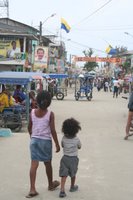 we start in Muisne, where they all have to vote. The elections here are a serious business. Every one has to vote, and there are also some laws about staying at home the night before, not drinking two days before… it’s interesting. Muisne is a nice little town, where everyone knows everyone. Maria was brought up here, and all the people are so nice to us. We also go to see the beach. It’s very beautiful, but I’m not in the mood for swimming. From Muisne we continue to Bunche. This is the town where Wilfrido was brought up in, and we live in his mom’s house. It’s a tiny little town, all the houses are from bamboo, and all the people are so nice! They all are very curious about me, and also about Jerico. They want to learn everything they can- English and Hebrew, and about how we live in Israel…
we start in Muisne, where they all have to vote. The elections here are a serious business. Every one has to vote, and there are also some laws about staying at home the night before, not drinking two days before… it’s interesting. Muisne is a nice little town, where everyone knows everyone. Maria was brought up here, and all the people are so nice to us. We also go to see the beach. It’s very beautiful, but I’m not in the mood for swimming. From Muisne we continue to Bunche. This is the town where Wilfrido was brought up in, and we live in his mom’s house. It’s a tiny little town, all the houses are from bamboo, and all the people are so nice! They all are very curious about me, and also about Jerico. They want to learn everything they can- English and Hebrew, and about how we live in Israel…
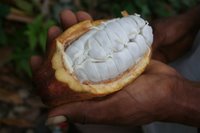
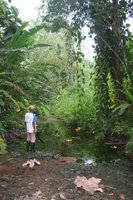 Day 4- Today I’m going with another friend of the family to see the cacao plantations. The plantations are located above the town, and it’s very beautiful up here. The man I’m going with is very quiet, and with my little Spanish the only conversation we develop is “um..” and “aha..” I hoped we would work in the plantations, but after a couple of hour’s trip we go back to the house.
Day 4- Today I’m going with another friend of the family to see the cacao plantations. The plantations are located above the town, and it’s very beautiful up here. The man I’m going with is very quiet, and with my little Spanish the only conversation we develop is “um..” and “aha..” I hoped we would work in the plantations, but after a couple of hour’s trip we go back to the house.
Day 5- Like most of the peripheral areas here in Ecuador, also in Bunche there is no running water, except for the river. Here in Bunche the river is salt, but there are some smaller rivers that run from the mountains to the main river, and they are with fresh water. From there the people in Bunche get their drinking, cooking and bathing water, and there they wash their clothes. Today we take the canoe and ride up to one of those smaller rivers. We take with us some food for later, and we settle there… Wilfrido is in charge of filling contains with water, and also of lighting up a fire to heat the food
Wilfrido is in charge of filling contains with water, and also of lighting up a fire to heat the food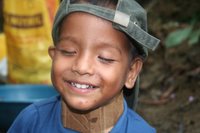 on. Maria is in charge of washing the clothes. Jerico sings and laughs and puts a smile on everyone’s faces. And me… well I do what I’m best at- taking photos.
on. Maria is in charge of washing the clothes. Jerico sings and laughs and puts a smile on everyone’s faces. And me… well I do what I’m best at- taking photos.
In a short walk in the area Wilfrido shows me some other cacao trees, mango trees, sugar canes, pineapple plants, papaya, and some other sorts… The land here is so rich, and I wonder how yet so poor.
Day 6- I go with Wilfrido to the cacao plantation again, to work there in planting seedlings. But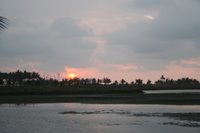 when we get there it turns out the man that is in charge of the planting, is not there. So we turn the way we came and go back to the house. Maria went to Muisne today, to buy some things, and Jerico is in the local kinder garden. When we come back I go to visit him, and we both are glad to see each other. Later this day we have a nice walk to the beach in Bunche.
when we get there it turns out the man that is in charge of the planting, is not there. So we turn the way we came and go back to the house. Maria went to Muisne today, to buy some things, and Jerico is in the local kinder garden. When we come back I go to visit him, and we both are glad to see each other. Later this day we have a nice walk to the beach in Bunche.
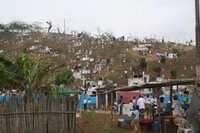 Day 7- Today is the ’day of the dead’. Something like the local version of Halloween. All people go to the graves of their loved ones to colour them white and tidy up there. The people are also dressed in white. In the evening it’s traditional to have big fiestas and go out and dance. I’ve never understood the connection between the dead and the celebrations… but who I’m I to say. Wilfrido’s dad is buried in Cabo San-Francisco, and we go there to contribute our share of the tradition. It’s interesting, and I also meet two other volunteers there, and finally get to speak some English! It has gotten to that that I even dream in Spanish, although I still don’t understand what exactly I’m saying in these dreams…
Day 7- Today is the ’day of the dead’. Something like the local version of Halloween. All people go to the graves of their loved ones to colour them white and tidy up there. The people are also dressed in white. In the evening it’s traditional to have big fiestas and go out and dance. I’ve never understood the connection between the dead and the celebrations… but who I’m I to say. Wilfrido’s dad is buried in Cabo San-Francisco, and we go there to contribute our share of the tradition. It’s interesting, and I also meet two other volunteers there, and finally get to speak some English! It has gotten to that that I even dream in Spanish, although I still don’t understand what exactly I’m saying in these dreams…
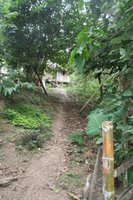 Day 8- With a lot of sorrow I say goodbye to Maria and Jerico, and go with Wilfrido to the other family I’ll stay at. They are an older couple that lives in the jungle in the area of Esmeraldas. The reservation is called ‘Machi Cindul’. It’s not possible to get with a car to where they live, so we get to the farthest place a car reaches, and then go by foot another five or six km to their house. The community is called Tigrilla, and lives next to a river. In the Secoya community, where I was two weeks before, the only way to get from one place to another is in a canoe. But here the river is smaller, and the jungle is less dense, so the easiest and most common way to get to places is by horses. I love horses, and I looked forward to ride. I learn that the man’s name is Segundo, and their grandson that is visiting them is called Andy (I don’t remember the women’s name…). They seemed very nice, but Segundo was talking to fast, and I had some trouble understanding him. The wife wasn’t talking much, and the one I had most contact with was Andy. After we had lunch, we went to work in the cacao plantation they have next to their house. Segundo picked the good cacao fruits of the trees, Andy opened them in half with his machete (a big knife), and I emptied the seeds into a bucket. We went from tree to tree, till we had two buckets full of cacao seeds. After the work I wanted to bathe in the river, but the mission seemed a bit complicated when every couple of minutes people rode by on their horses, and Andy found exactly this moment to wash his horse in the river. Well not much bathing today, but I can live with that…
Day 8- With a lot of sorrow I say goodbye to Maria and Jerico, and go with Wilfrido to the other family I’ll stay at. They are an older couple that lives in the jungle in the area of Esmeraldas. The reservation is called ‘Machi Cindul’. It’s not possible to get with a car to where they live, so we get to the farthest place a car reaches, and then go by foot another five or six km to their house. The community is called Tigrilla, and lives next to a river. In the Secoya community, where I was two weeks before, the only way to get from one place to another is in a canoe. But here the river is smaller, and the jungle is less dense, so the easiest and most common way to get to places is by horses. I love horses, and I looked forward to ride. I learn that the man’s name is Segundo, and their grandson that is visiting them is called Andy (I don’t remember the women’s name…). They seemed very nice, but Segundo was talking to fast, and I had some trouble understanding him. The wife wasn’t talking much, and the one I had most contact with was Andy. After we had lunch, we went to work in the cacao plantation they have next to their house. Segundo picked the good cacao fruits of the trees, Andy opened them in half with his machete (a big knife), and I emptied the seeds into a bucket. We went from tree to tree, till we had two buckets full of cacao seeds. After the work I wanted to bathe in the river, but the mission seemed a bit complicated when every couple of minutes people rode by on their horses, and Andy found exactly this moment to wash his horse in the river. Well not much bathing today, but I can live with that…
After dinner, I went on a horseback riding tour with Andy. Or, truth to be told, I was riding, and he was walking next to me. When we got to a place where we had to cross the river in a deep spot Andy jumped on the back of the horse like it’s the easiest thing to do, and we rode over. For some reason, no matter how much I was kicking the horse, he would go over only to trot (slow running) and never galloping. On the way back to their home, Andy got on the back again, and after a few kicks I saw the horse could indeed gallop… so fun!
There is no electricity here, so the evening is very dark, and we go to sleep early.
 Day 9- Segundo went to the closest town to sell the cacao we raised yesterday, and to buy some food. I went with Andy and another friend of him to work with the horses. We go to a place in the forest where there are trees that had been cut down and cut into planks. Andy and his friend tie four or five planks at both sides of the horses, and then we shooed them back the way we came, to the river. When we get to the river they untie the planks again. From there they are taken, usually by young children, to the nearest town, to be sold. Then we go back to the place where the planks are, and the whole thing was done over again. When we had a nice pile of planks near the river, and our stomachs were starting to make loud noises, we went back to the house for lunch.
Day 9- Segundo went to the closest town to sell the cacao we raised yesterday, and to buy some food. I went with Andy and another friend of him to work with the horses. We go to a place in the forest where there are trees that had been cut down and cut into planks. Andy and his friend tie four or five planks at both sides of the horses, and then we shooed them back the way we came, to the river. When we get to the river they untie the planks again. From there they are taken, usually by young children, to the nearest town, to be sold. Then we go back to the place where the planks are, and the whole thing was done over again. When we had a nice pile of planks near the river, and our stomachs were starting to make loud noises, we went back to the house for lunch.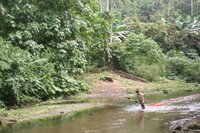 After lunch I went with Segundo (who had returned by this time) to the cacao plantation, to work in cutting the new brunches. In this way the tree grows high and strong, he explained.
After lunch I went with Segundo (who had returned by this time) to the cacao plantation, to work in cutting the new brunches. In this way the tree grows high and strong, he explained.
During dinner Segundo asked me if I like dancing. I answered I like dancing, but I don’t know how to dance salsa. I thought he was only asking out of curiosity, but then he said- “OK, today we go dancing”. I wondered if he meant for real, because we were in the middle of nowhere, but his face did not show any sign of laughing. ‘I’ll wait and see’, I thought, and indeed- at around nine we go out on our way to the nearest pub. It was a funny scene- I went with two grandparents and their grandson on the dark road, when the moon is the only light for us, and as we pass other houses Segundo shouts to the neighbours, inviting them to come with us. We went for about an hour, now you have to remember- this people are usually fast asleep at this hour. We passed a place where you could hear music coming out of and it also had lights (rear privilege in this place), so I assumed this is the place. But no, it turns out we are going to an even better pub! One more river to cross, and around 15 more minutes, and we arrive. The house is a private house. The first floor is used as a dance floor. Outside there are two billiard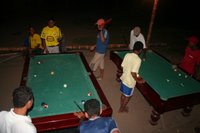 tables, and some teenagers are playing. When we get inside there is no music, and we find out that the owner has gone to sleep. But, the arriving of visitors is a big thing, and the owner came down to us after a few minutes. She sat on some music, but there were no one there except me and the grandparents, so I joined Andy and the other boys outside. I play a few games of billiard, and was actually not as bad as I thought. After a short while, some men in their forties, that herd the invitation of Segundo, begin coming one by one. Segundo ask me to dance, but I say I don’t want to. He says they came all this way only because I said I wanted to dance, and now I can’t say no… I feel guilty, but on the other side I really don’t feel like being the only one dancing in front of all this elderly men (and shall the less young readers forgive me…). Only later comes two younger ladies (around my age I would guess, but then again most of the women at my age here are married with children, so probably they were a bit younger.) The younger boys come inside to, and the dancing starts. I dance at first with Andy, but he is too good of a salsa dancer for me, and is also way to enthusiastic to show it… I can’t follow his quick steps, and go over to dance with the slower ones. I have a great time, but I still feel a bit clumsy in comparison with the others here… they know how to move, shall I tell you!
tables, and some teenagers are playing. When we get inside there is no music, and we find out that the owner has gone to sleep. But, the arriving of visitors is a big thing, and the owner came down to us after a few minutes. She sat on some music, but there were no one there except me and the grandparents, so I joined Andy and the other boys outside. I play a few games of billiard, and was actually not as bad as I thought. After a short while, some men in their forties, that herd the invitation of Segundo, begin coming one by one. Segundo ask me to dance, but I say I don’t want to. He says they came all this way only because I said I wanted to dance, and now I can’t say no… I feel guilty, but on the other side I really don’t feel like being the only one dancing in front of all this elderly men (and shall the less young readers forgive me…). Only later comes two younger ladies (around my age I would guess, but then again most of the women at my age here are married with children, so probably they were a bit younger.) The younger boys come inside to, and the dancing starts. I dance at first with Andy, but he is too good of a salsa dancer for me, and is also way to enthusiastic to show it… I can’t follow his quick steps, and go over to dance with the slower ones. I have a great time, but I still feel a bit clumsy in comparison with the others here… they know how to move, shall I tell you!
Day 10- Today there is a meeting held about how to preserve the ‘Machi Chindul’ reserve. The meeting is in another community, and we get there by horses. The ride there takes about one hour and is very beautiful. At first I get on Segundo’s horse, and he gets on another one. But, like the day before, I can’t get the horse to go any faster than trotting every now and then, so I switch horses with Segundo. The other horse I go on is a fast one, but now the young boy of the horse owner is sitting behind me. At start I’m afraid of galloping with him sitting back there with no sadle or nothing. The boy’s father asks me why I’m not going any faster, and laughs when I say I’m afraid for the boy. He says that I’m one to worry for and not the boy. Here they can ride since they are three years old! From there on I’m galloping all the way. What a great feeling! During the meeting there is not much for me to do, so I’m glad that after three hours we start our ride back. I get a bit annoyed when, after we are back from the tour, Segundo asks me for five dollars for it…
reserve. The meeting is in another community, and we get there by horses. The ride there takes about one hour and is very beautiful. At first I get on Segundo’s horse, and he gets on another one. But, like the day before, I can’t get the horse to go any faster than trotting every now and then, so I switch horses with Segundo. The other horse I go on is a fast one, but now the young boy of the horse owner is sitting behind me. At start I’m afraid of galloping with him sitting back there with no sadle or nothing. The boy’s father asks me why I’m not going any faster, and laughs when I say I’m afraid for the boy. He says that I’m one to worry for and not the boy. Here they can ride since they are three years old! From there on I’m galloping all the way. What a great feeling! During the meeting there is not much for me to do, so I’m glad that after three hours we start our ride back. I get a bit annoyed when, after we are back from the tour, Segundo asks me for five dollars for it…
Day 11- Today is my last day here. Andy gets the horse ready, and puts my bag on it. We start the walking towards the closest town where the bus stops. The hour is five thirty in the morning, and we have around two hours of walking. But the time goes fast by, as we chat (as much as I can chat with my little Spanish) and laugh.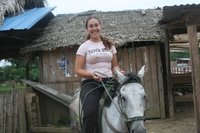
From here I continue to Santo- Domingo, but on my way I stop in Tonchigue to say one more goodbye to my loved Jerico.
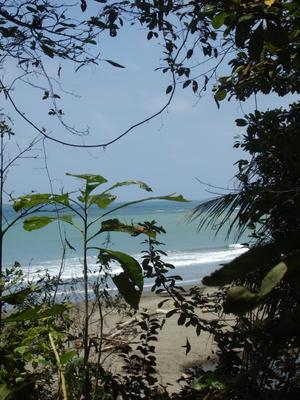
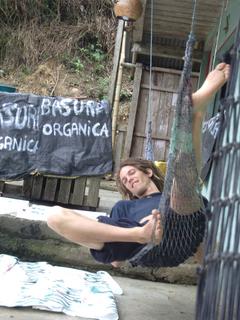

 Puis nous avons découvert la maison d'Elsa, certes prête à s'écrouler, avec peu d'électricité et sans eau courante mais tellement pleine de vie avec ses 6 enfants extraordinaires ! Malgré le degré important de pauvreté, nous avons découvert une famille unie et heureuse et ainsi eu la chance de partager leur quotidien. Il nous aurait fallu rester un peu plus de temps pour atteindre leur efficacité lors de la lessive à la rivière ou encore des déplacements à cheval pour aller chercher de l'eau douce mais nous nous sommes tout de même débrouillés !
Puis nous avons découvert la maison d'Elsa, certes prête à s'écrouler, avec peu d'électricité et sans eau courante mais tellement pleine de vie avec ses 6 enfants extraordinaires ! Malgré le degré important de pauvreté, nous avons découvert une famille unie et heureuse et ainsi eu la chance de partager leur quotidien. Il nous aurait fallu rester un peu plus de temps pour atteindre leur efficacité lors de la lessive à la rivière ou encore des déplacements à cheval pour aller chercher de l'eau douce mais nous nous sommes tout de même débrouillés !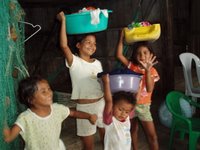 Parallèlement, nous avons fait la connaissance d'habitants chaleureux, prêts à faire des efforts pour développer leur communauté. Notre mission a donc commencé par un nettoyage de la plage avec tous les villageois et s'est terminé par une réunion très officielle. Considérés comme des "envoyés de Quito" pleins de solutions, nous avons donc transmis la bonne parole, tels des prophètes, et tout le monde s'est motivé ! Entre temps, nous avons aussi construit, à la pioche et à la machette, un sentier menant au sommet d'une colline permettant de voir passer les baleines.
Parallèlement, nous avons fait la connaissance d'habitants chaleureux, prêts à faire des efforts pour développer leur communauté. Notre mission a donc commencé par un nettoyage de la plage avec tous les villageois et s'est terminé par une réunion très officielle. Considérés comme des "envoyés de Quito" pleins de solutions, nous avons donc transmis la bonne parole, tels des prophètes, et tout le monde s'est motivé ! Entre temps, nous avons aussi construit, à la pioche et à la machette, un sentier menant au sommet d'une colline permettant de voir passer les baleines. Ainsi, contrairement à nos premiers impressions, nous avons pu amorcé plusieurs projets écotouristiques prometteurs comme une sortie-expérience de la pêche au poulpe (on ne rit pas !), un sentier découverte des arbres fruitiers tropicaux (avec dégustation sur place), la visite de l'atelier d'artisanat ou encore des sorties en mer pour pêcher ou observer les baleines.
Ainsi, contrairement à nos premiers impressions, nous avons pu amorcé plusieurs projets écotouristiques prometteurs comme une sortie-expérience de la pêche au poulpe (on ne rit pas !), un sentier découverte des arbres fruitiers tropicaux (avec dégustation sur place), la visite de l'atelier d'artisanat ou encore des sorties en mer pour pêcher ou observer les baleines.  Mais il reste encore tout à faire pour les prochains volontaires qui devront désormais réaliser tous ces beaux projets !
Mais il reste encore tout à faire pour les prochains volontaires qui devront désormais réaliser tous ces beaux projets !


















